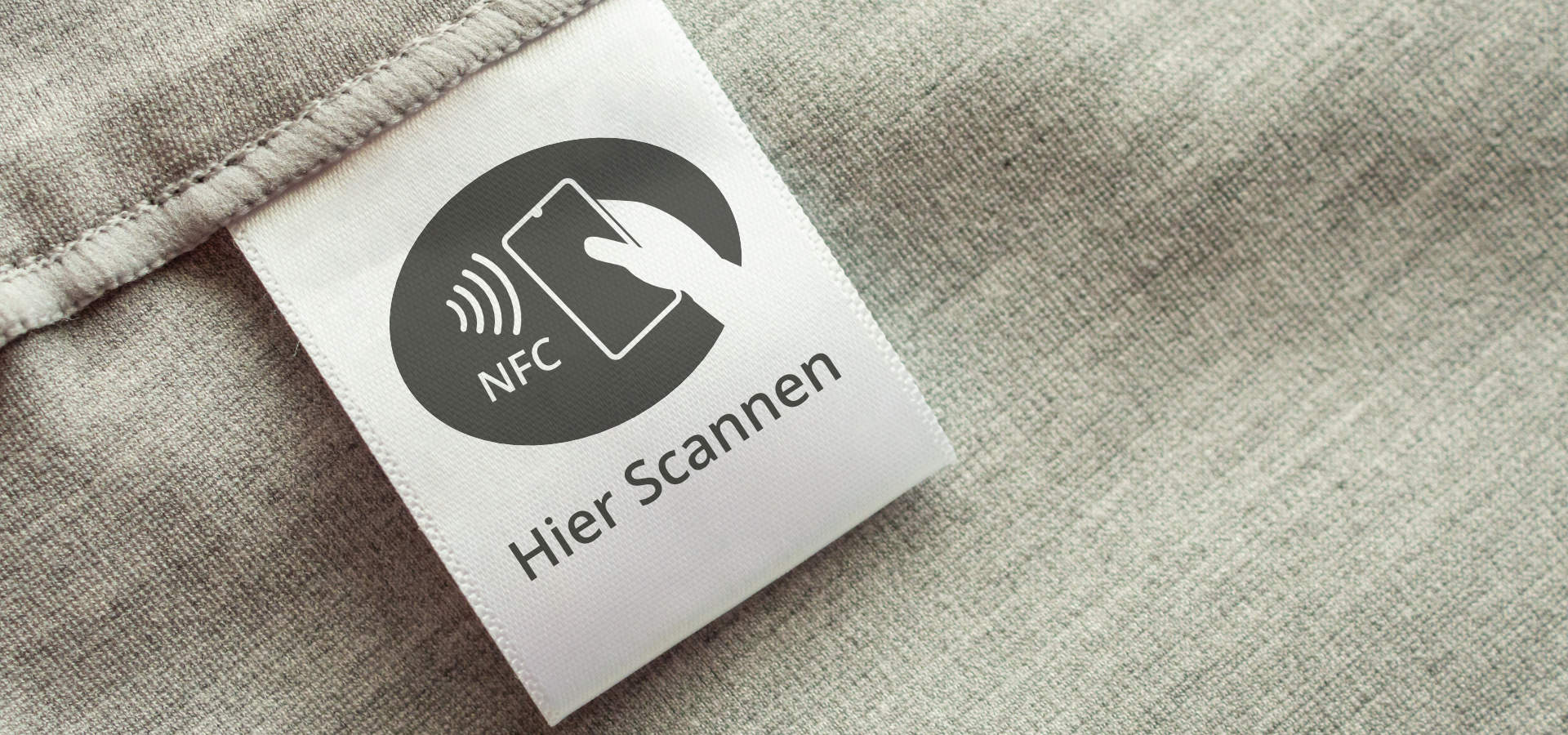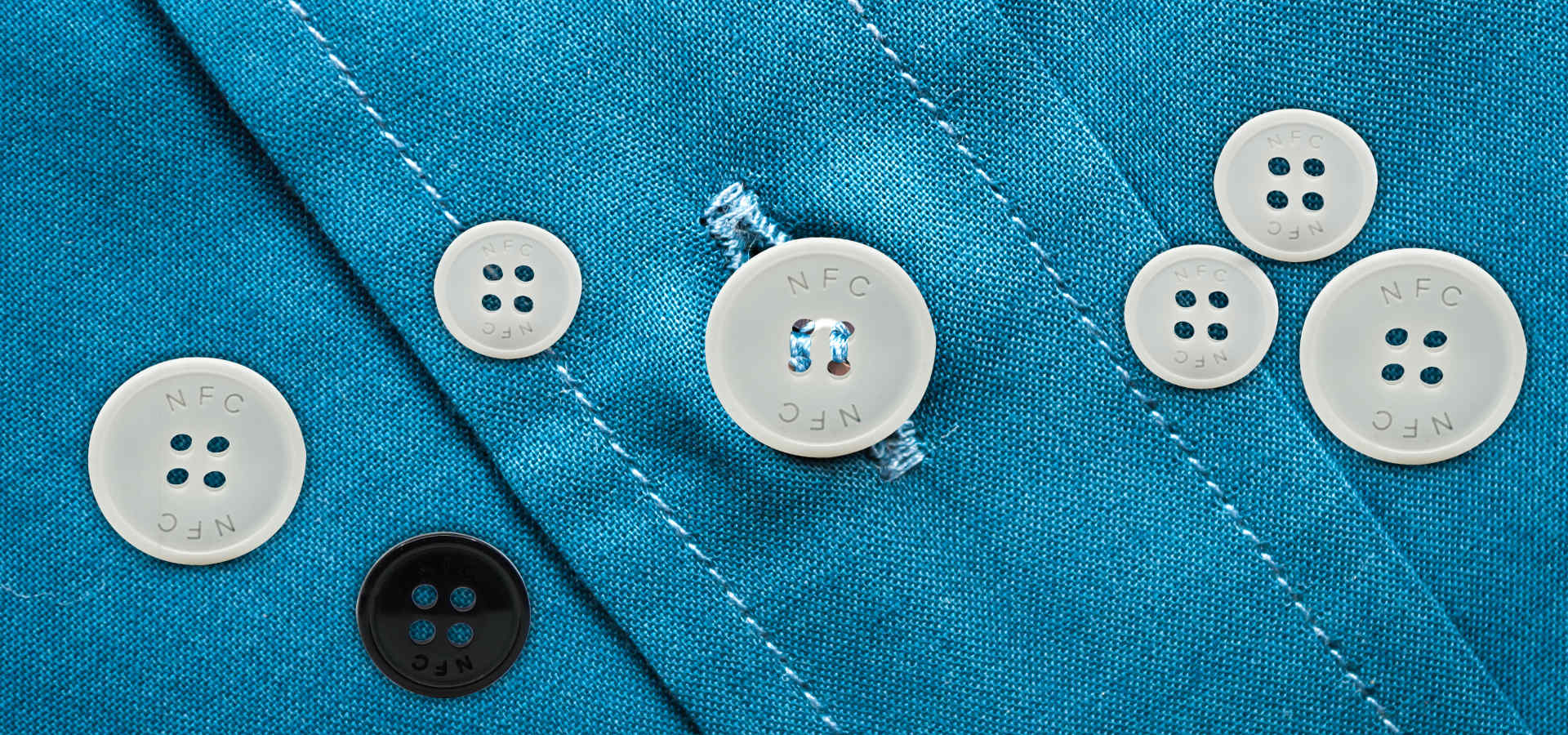NFC in clothing - digitalisation of the clothing industry

Global developments have always had a major influence on fashion, fashion trends and the clothing industry. Two aspects in which this can be seen are on the one hand the increasingly important factor of sustainable production and distribution and on the other hand the need to ensure originality in order to prevent counterfeiting of inferior quality.
This article is intended to shed light on the topic of the digitisation of garments based on NFC and to show how NFC can support the above-mentioned objectives and what examples already exist on the market.
Basics of NFC in garments
As explained in the basic article on NFC, NFC tags can be read by all modern smartphones, for example to automatically open a website. This is the basis for all use cases that are intended to offer the end customer additional added value. For example, an NFC tag embedded in a laundry label could in the simplest case provide more detailed care instructions than would fit on a conventional label. However, the fact that an NFC tag has additional mechanisms that ensure its uniqueness (e.g. globally unique serial number) means that much more far-reaching applications can be realized, as will be shown below.
NFC in garments for clear traceability
The production conditions of large clothing manufacturers are always the focus of media attention. Unfortunately, all too often it is only due to scandals that occur in various production countries. The origin and manufacturing process of clothing is therefore becoming increasingly important and is considered an additional factor in the purchase decision. Due to the global ramification of production and supply chains, creating transparency is one of the main challenges.
By using a unique NFC tag, it is possible to present not only basic product information but also a clear history of the product. For example, the individual production steps can be tracked along the production chain by scanning the NFC tag in the garment. NFC tags are robust against external influences and more forgery-proof than conventional clothing labels. Traceability, transparency and individuality can thus be raised to a whole new level. In the following we would like to present some examples that already use NFC for such purposes.
NFC chip in shoe to track production
Sneaker manufacturer Satoshi equips its products with its own NFC chip to inform the customer about the production route of each pair of shoes. Among other things, the chip provides information about the manufacturing location and process. Where other products usually only show the country of origin, Satoshi shows for each pair of shoes when and where it was processed.
The technology behind the NFC chip is that it is linked to an online portal that stores each step in the process and additionally signs it using a block chain algorithm. Access to the information and its extension is done by scanning the shoe. This technology also makes it possible for subsequent owners to add themselves to this block chain. Thus, further owners can see to whom the shoes have already belonged once. By using NFC in its own products, Satoshi wants to demonstrate to its customers in a comprehensible and uncomplicated way which production steps their own shoes have gone through. This traceability makes each production step transparent, which among other things ensures that the sneakers were manufactured under fair conditions.
NFC for detailed material origin in sweaters

A clothing manufacturer goes even further and offers its customers even more transparency through the use of modern NFC technology in clothing. SheepInc not only uses high-quality materials and workmanship to make the garments more durable, the company also incorporates a small NFC chip the size of a button in each garment. This NFC button provides information about the production, the origin and even - and this is the special thing - from which sheep the wool comes. To get information such as name, size, weight, origin and breed of the sheep, all you have to do is hold your smartphone over the NFC button. The manufacturer thus offers the possibility to get information about the welfare of the animal and to establish a certain relationship with it. The buyer is also shown how much CO2 the purchase of the product has saved. Through the unique ID of the NFC tag, each sweater has its own history. The linked information is stored on the internet and can therefore always be flexibly adapted, so that the status of the sheep is not a snapshot, but continues to exist with the sweater and can also change. NFC allows the information to be communicated efficiently and quickly and to be noted on each individual pullover.
NFC for additional services to the garment
The Swiss mountain sports clothing manufacturer Mammut has been using an NFC chip in its garments (MammutConnect) for the first time since 2019. The scan of this chip provides access to its own app, which offers the customer information and service offers for the purchased product even after the purchase, such as after-sales support or an extended warranty. In addition, the app can also be used to upload experiences and photos from a trip or tour. The manufacturer uses NFC technology to stay in touch with each customer individually and also offers an exchange with the community through the stored online interface. The NFC chip is something like a speed dial button for product information, services and community access. Never before has this been possible solely by contact with an item of clothing. The mountaineering clothing manufacturer also benefits from another advantage of NFC chips: With the right processing, NFC tags in clothing are very robust and weatherproof and can therefore withstand heavy rain or washing.
NFC in garments against counterfeiting
Each NFC tag has a unique ID (UID) that exists only once in the world, so each product can be identified as unique. The unique serial number of an NFC tag can therefore be used to ensure that a product is counterfeit-proof. The advantage over conventional counterfeit protection is the digital, central database of all UIDs, which is stored online. This enables both the manufacturer and the customer to check the authenticity by simply scanning the NFC tag. This makes every NFC garment counterfeit-proof.
An NFC tag can be processed invisibly or visibly in a garment. Deceptively genuine replicas and plagiarisms can thus be unmasked by a quick scan. In some nations, such as Russia, products such as shoes and clothing have been legally marked and traceable since 2018 (Government Resolution No. 792-R of April 28, 2018). Each product must be marked here with a unique code and bowl. By implementing an NFC tag when creating the respective product, this principle can be transferred to all conceivable items of clothing.
NFC tags particularly robust in clothing
NFC chips are small and can be processed in a variety of ways. As they are flexible, they can also be easily incorporated into textiles. Such processed NFC tags must be able to withstand washing, weather conditions and various external influences. Since NFC chips can also be scanned through plastics and fabrics, they can be well encased and protected by robust materials. For example, our NFC laundry tag is protected under water in a PPS material in accordance with the IP68 standard.
In addition to NFC labels, buttons also lend themselves well to the integration of an NFC chip. Two small erasers allow the NFC chip to be attached to clothing like a button. The NFC button is also waterproof and can withstand temperatures of up to 180°C and even chemicals.
Summary
NFC tags allow various information to be stored in a small space and without a power source. Access is conveniently via smartphone scan. In addition, NFC tags are usually very small, thin and flexible, making them easy to process in textiles. Each tag has its own identification number (UID), which makes the tag, and thus the product, unique. The UID can be secured and managed by a central database, which makes the product forgery-proof.
In this basic article we will show many more use cases. If you have questions regarding more detailed use cases and product details, please contact us. We are also happy to help you with specific questions regarding our robust and resistant NFC products!
